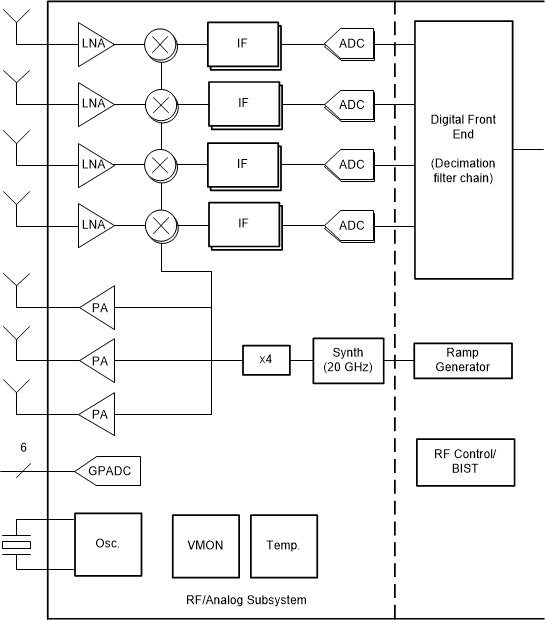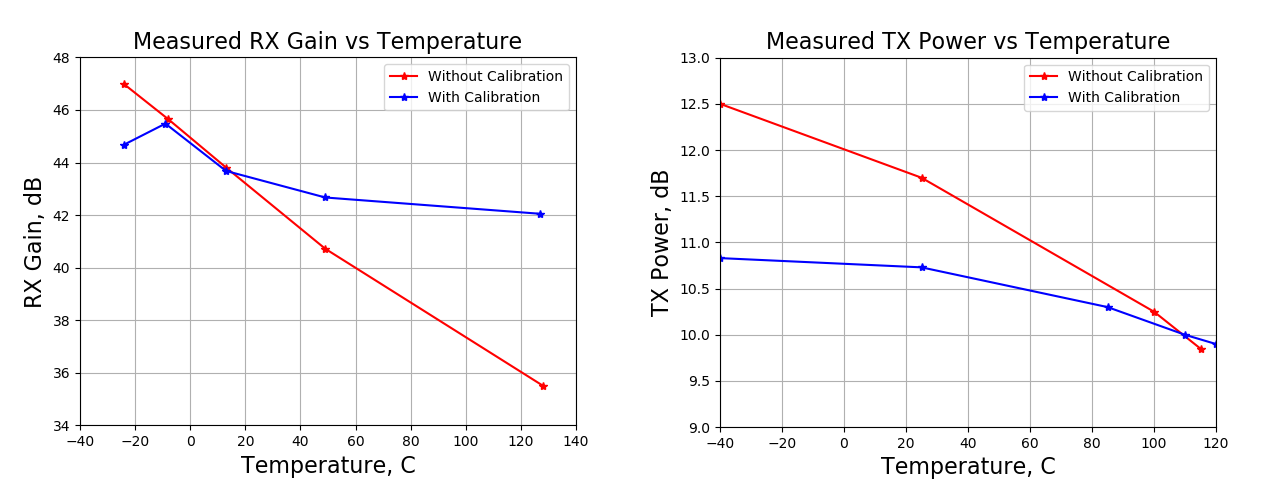SPRACF4C June 2018 – January 2023 AWR1243 , AWR1443 , AWR1642 , AWR1843 , AWR1843AOP , AWR2243 , AWR2944 , AWR6843 , AWR6843AOP , IWR1843 , IWR2944 , IWR6443 , IWR6843 , IWR6843AOP
- Trademarks
- 1Introduction
- 2Hardware Infrastructure to Support Calibration and Monitoring
-
3List of Calibrations
- 3.1 APLL Calibration
- 3.2 Synthesizer VCO Calibration
- 3.3 LO Distribution Calibration
- 3.4 ADC DC Offset Calibration
- 3.5 HPF Cutoff Calibration
- 3.6 LPF Cutoff Calibration
- 3.7 Peak Detector Calibration
- 3.8 TX Power Calibration
- 3.9 RX Gain Calibration
- 3.10 IQ Mismatch Calibration
- 3.11 TX Phase Shifter Calibration
- 4Impact of Calibration on Gain and Phase
- 5Impact of Interference on the Calibrations and Emissions Caused Due to Calibrations
- 6Scheduling of Runtime Calibration and Monitoring
-
7Software Controllability of Calibration
- 7.1 Calibration and Monitoring Frequency Limits
- 7.2 Calibration and Monitoring TX Frequency and Power Limit
- 7.3 Calibration Status Reports
- 7.4 Programming CAL_MON_TIME_UNIT
- 7.5 Calibration Periodicity
- 7.6 RF Initialization Calibration
- 7.7 Runtime Calibration
- 7.8 Overriding the TX Power Calibration LUT
- 7.9 Overriding the RX Gain Calibration LUT
- 7.10 Retrieving and Restoring Calibration Data
- 8References
- A Calibration and Monitoring Durations
- Revision History
1.1 Purpose of Calibrations
Figure 1-1 illustrates the radar front-end architecture in a TI mmWave radar device. The performance parameters of the RX LNA, IF amplifiers, TX PA, X4 (frequency multiplier), LO distribution buffers, and the clock sources shown all vary with process and temperature.
 Figure 1-1 Radar Front-End Architecture in a TI mmWave Device
Figure 1-1 Radar Front-End Architecture in a TI mmWave DeviceThe purpose of calibrations is illustrated in Figure 1-2 using RX gain and TX power as examples. The gain of the RX LNA and the TX PA vary from device to device due to manufacturing process variations and also across temperature. The purpose of calibration is to ensure the RX gain and output power are maintained as configured by the user despite variations in process and temperature. To achieve this, the internal processor adjusts the mmWave circuit configurations at initialization (to mitigate effects of process variation) and periodically at runtime (to mitigate effects of temperature drifts). Figure 1-2 illustrates how calibration can be used to maintain the RX Gain and TX Power close to the configured settings across temperature drifts. These charts are illustrative and may not reflect actual device performance. Even with these calibrations done across temperature there would be some gain variations between devices, which must be considered in the user application.
 Figure 1-2 RX Gain and TX Power With and Without Calibration
Figure 1-2 RX Gain and TX Power With and Without CalibrationThese are representative plots on TI's first generation radar devices. Some of the calibrations (for example, the gain and power calibrations) are implemented as adjustments of circuit configurations based on measurement of RF/analog parameters. Other calibrations are implemented as adjustments based on process/temperature look up tables.